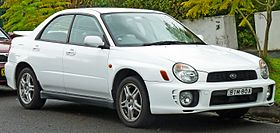Saab 9-2X
| Subaru Impreza (second generation) | |
|---|---|
 |
|
| Overview | |
| Manufacturer | Subaru (Fuji Heavy Industries) |
| Also called | Subaru Outback Sport Saab 9-2X (2004–2005) Chevrolet Impreza |
| Production | 2000–2007 |
| Assembly | Japan: Ōta, Gunma |
| Designer | Hidefumi Kato (1998) Peter Stevens (2001) Andreas Zapatinas (2004) |
| Body and chassis | |
| Class | Compact |
| Body style | 4-door sedan (GD) 5-door hatchback (GG) |
| Layout |
Front-engine, front-wheel drive Front-engine, all-wheel drive |
| Powertrain | |
| Engine | 1.5 L EJ15 F4 1.6 L EJ16 F4 2.0 L EJ20 F4 2.0 L EJ20 F4 (t/c) 2.5 L EJ25 F4 2.5 L EJ25 F4 (t/c) |
| Transmission | 4-speed automatic 5-speed manual 6-speed manual |
| Dimensions | |
| Wheelbase | 2,525 mm (99.4 in) |
| Length | 4,415 mm (173.8 in) |
| Width | Sedan: 1,730 mm (68.1 in) Hatchback: 1,695 mm (66.7 in) |
| Height | 1,425 mm (56.1 in) |
| Curb weight | 1,390 kg (3,064.4 lb) |
| Chronology | |
| Predecessor | Subaru Impreza (first generation) |
| Successor | Subaru Impreza (third generation) |
The Subaru Impreza (second generation) is a compact car manufactured between 2000 and 2007 by Subaru in Ota, Gunma, Japan.
As with its first generation predecessor, Subaru split the range into four-door sedan (GD series) and five-door hatchback (GG series) body variants; the firm did not carry forward the previous coupe style. Mainstream versions received naturally aspirated 1.5-, 1.6-, 2.0-, or 2.5-liter flat-four engines, with the performance oriented "WRX" and "WRX STI" models uprated to turbocharged versions of the two latter options. Like most Subaru models of similar vintage, all-wheel drive tended to be offered as standard in export markets, with front-wheel drive also available in Japan.
Introduced as the "New Age" Impreza, the polarizing headlamp styling divided critics who were quick to designate the model as the "bug eye" Impreza. A subsequent facelift in 2002 toned down this frontal styling, but a second facelift in 2005—characterized by an aviation-inspired three-part mesh grille—also attracted controversy.
Built on a significantly modified version of the first generation platform, the new Impreza followed much the same formula as its predecessor, including a similarly contoured silhouette. Despite this, the front-end styling—distinguished by ovoid headlamps—attracted significant controversy. Body dimensions for the sedan increased by 45 millimetres (1.8 in) in length, 40 millimetres (1.6 in) in width, and 25 millimetres (1.0 in) in height; wheelbase increased by 5 millimetres (0.2 in). To satisfy Japanese vehicle size tax regulations, the width of the hatchback increased by just 5 millimetres (0.2 in) to 1,695 millimetres (66.7 in) and therefore remaining in the limit "5" classification. As Subaru had intended to homologate the sedan chassis for rallying, the decision to increase the width of the sedan—which placed it into the higher taxed number "3" division—brought added stability. Likewise, the 20-millimetre (0.8 in) increase in track for the sedan also worked to aid handling, with the hatchback gaining just 5 millimetres (0.2 in). Other main improvements to the chassis included a 120 percent increase in torsional rigidity; mainly due to revisions in front subframe design. The suspension retained its basic MacPherson strut in the front and rear, although Subaru altered the geometry.
...
Wikipedia
